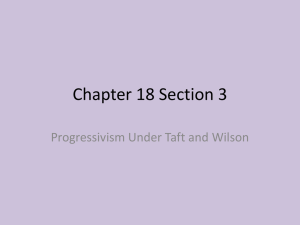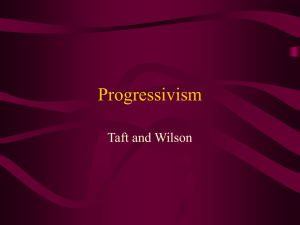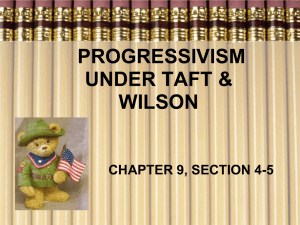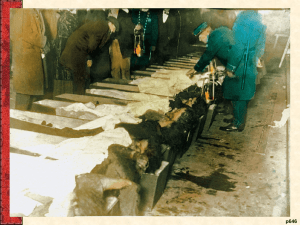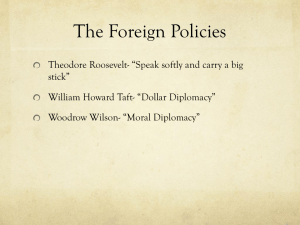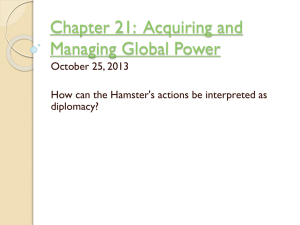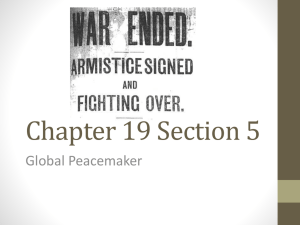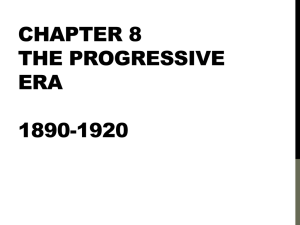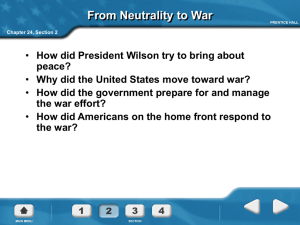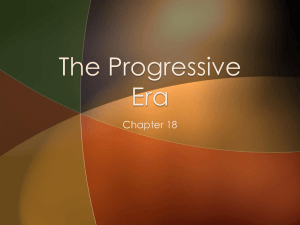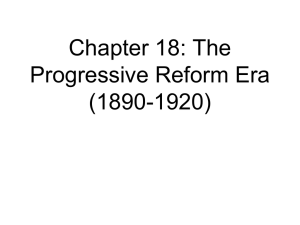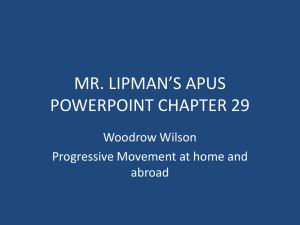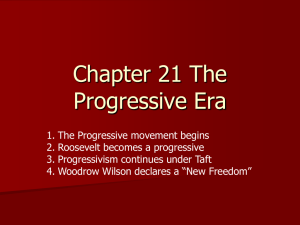Progressivism Under Taft and Wilson
advertisement
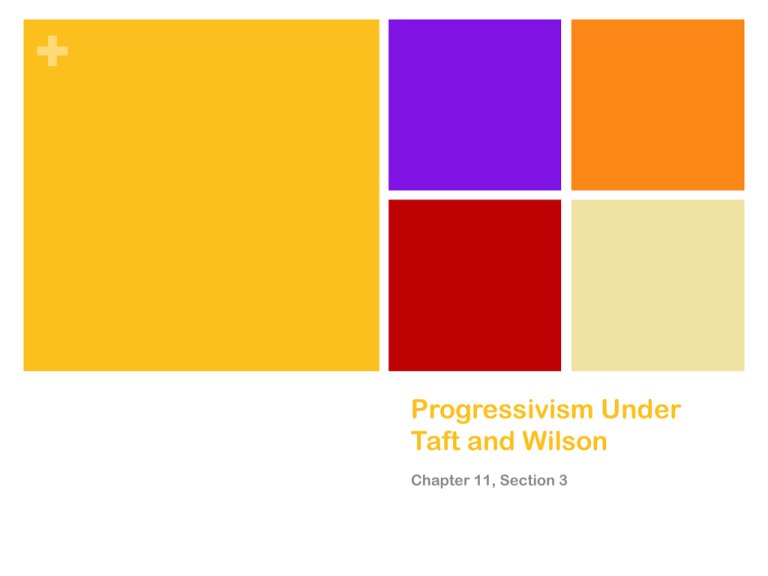
+ Progressivism Under Taft and Wilson Chapter 11, Section 3 + Taft’s Presidency TR decided not to seek another term and asked Taft to, Taft wanted to become the Chief Justice and had no interest in the Presidency but TR and his wife talked him into it He defeated the Democrat Bryan in 1908 and pledged to carry out TR’s progressive programs He was not TR and did not have his strength or will to carry out the job Taft was not a popular president; what do you know about him? + President Taft + Conflict Over Tariffs In 1908 Taft ran on a platform (?) of lower tariffs (a Progressive goal that TR had failed to address) Taft called a special session of Congress in 1909 to reduce tariffs Congress passed the Payne-Aldrich Tariff that lead to some reductions but mostly increases and Progressives were furious + The Ballinger-Pinchot Affair Taft also angered conservationists (people in favor of the protection of natural resources) He appointed Richard Ballinger as the Secretary of the Interior and he was known for taking the side of business when it came to preservation of western lands Pinchot, the head of the U.S. Forest Service, had many conflicts with Ballinger Pinchot has been TR’s helper in drafting the legislation that lead to many of the conservationist efforts and he was quite popular among Progressives Pinchot caught Ballinger giving use of public lands in Alaska to businesses and called him out, Taft backed Ballinger and lost even more favor + Turmoil in the Republican Party: Midterm Elections 1910 Following the election of 1908, TR went to East Africa on Safari and returned right before the elections in 1910 He at first backed his old friend Taft, but quickly changed his mind and campaigned for the Progressive candidates backing business regulation, welfare laws, workplace protection for women and children, income and inheritance taxes and voting reform—He called his plan “New Nationalism” Democrats gained control in the House and the Senate + The Election of 1912 TR challenged Taft for the Republican nomination but lost Progressive Republicans backed TR and created their own party, The Bull Moose Party (named because people questioned whether TR was too old to hold office and he said was “as fit as a bull moose” The Bull Moose party ran on a platform of tariff reductions, women’s suffrage, regulation of business, child labor ban, eight hour work day, worker’s compensation plan, direct election of senators On 10/14 TR was shot while giving a speech but asked the crowd to quiet down and finished. He was only alive because his speech and glasses were so thick + TR Gets Shot + TR is a Bull Moose Theodore Roosevelt worked hard to prove that he was as healthy and strong as ever and could run the country. + Taft’s Record: The Republican Taft frequently complained about his job; “politics make me sick” He preserved more federal lands, brought more antitrust suits than TR and supported the Children’s Bureau, passed the 16th and 17th amendments and gave the Interstate Commerce Commission the power to regulate telephone and telegraph rates + Woodrow Wilson: The Democrat New Jersey Governor He criticized big business and big government He promoted a “New Freedom” policy and promised to enforce antitrust laws without threatening economic competition + Woodrow Wilson Wilson had served as the governor of New Jersey, had a reputation as a dedicated reformer and had been a college political science professor. He believed one of his main duties as president was to present legislation to Congress, promote it publicly and guide it to legislation. + The Election It is very difficult in a heated three way race for the party that is closest to the third candidate (in this case Republicans and Bull Moose) Wilson won the election with 42% of the popular vote but won the electoral college by a landslide, 435 (Wilson) 88 (TR) and 8 (Taft); how does this system work? + Tariffs and Taxes Wilson reduced tariffs; the Underwood Tariff Act of 1913 reduced average tariff rates from 40-25% To make up for the loss of tariff revenue to the government, Wilson signed into a law a federal income tax that was then made legal with the 16th amendment in 1913 + Attacking the Trusts Wilson believed that trusts/monopolies limited free enterprise and wanted to get rid of them In 1914 Wilson guided Congress to pass the Clayton Antitrust Act to strengthen the Sherman Antitrust Act It didn’t just make them illegal as Sherman had done but spelled out practices that businesses could not do It also said that labor unions could not be punished as or labeled as trusts because the labor of a human is not a business entity The Federal Trade Commission was set up to enforce the act + The Federal Reserve System Wilson wanted to regulate the banking industry and help stabilize the nation’s economy He pushed congress to pass the Federal Reserve Act of 1913 and created the Federal Reserve System The system divided the nation into 12 districts each with a Federal Reserve Bank that was owned by its member banks and supervised by a Federal Reserve Board whose members are appointed by the president Each bank was required to become a member of the Federal Reserve and could borrow money from the Reserve for short term loans when too many depositors wanted their money back at one time + Brandeis to the Supreme Court Known as “the people’s lawyer” for fighting many public issues Was appointed by Wilson He was the first Jewish member of the Supreme Court Together Wilson and Brandeis worked to make and preserve federal legislation dealing with child labor + The Election of 1916: Wilson Wins Charles Evans Hughes ran on the Republican ticket and was backed by the progressives and the Bull Moose Party Wilson successfully ran on the slogan that he kept the country out of World War I, which started in Europe in 1914 *** Wilson is inaugurated in March of 1917 and we enter WWI in April of 1917 + Limits of Progressivism Progressives focused mainly on municipal (city level) problems Progressives did little to aid migrant farmers and nonunionized workers Some Progressives supported immigration limits and literacy tests + Social Justice and Progressivism Wilson did nothing to stop Jim Crow Wilson initially was against women’s suffrage; sadly those democrats who did support women’s suffrage usually only did so because it would add to the white vote and put African Americans further behind TR also did little to support African Americans TR, Taft and Wilson were all afraid that if they supported expanded civil rights, they would lose southern votes + The End of Progressivism WWI really brought about the end of the movement As more nations in Europe got dragged into the war, we were concerned we would be too and started to focus on preparation
